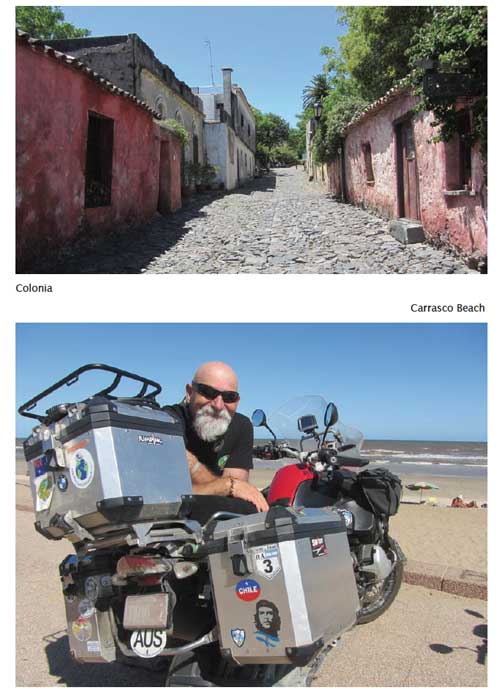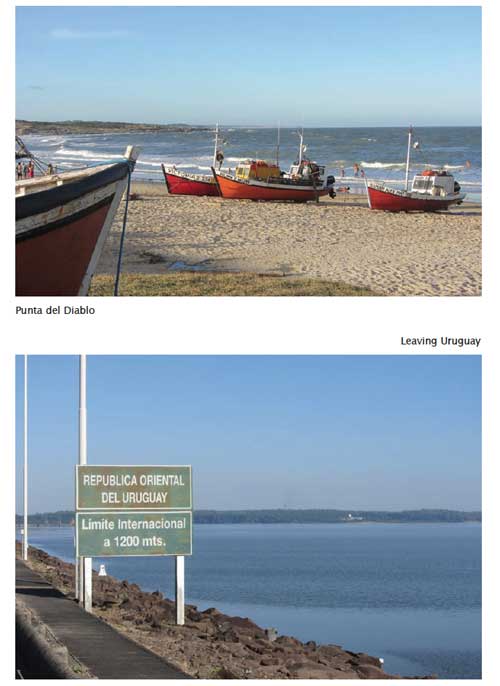
13 – 23 January 2012
Brian: Before we can cross the massive River Plate for Uruguay we need to make another major redistribution of weight on the bike. It’s too top heavy and that’s not good. To lessen the weight on the top box I shift the liners and waterproofs into the bag on the top. We’ve got too much stuff despite posting half a kilo home a few days ago.
We’re booked on the 9.30 am ferry from Buenos Aires to Colonia del Sacramento in Uruguay. It’s a three-hour cruise across the River Plate and a most unusual border crossing. We’re stamped out of Argentina and into Uruguay at the dock. On the ferry they stamp the carnet for the motorcycle.
Shirl lines up with the other pedestrians, not allowed to ride onto the ferry with me. In the car hold there aren’t any tie downs, but everyone assures me the crossing will be smooth.
They’re right. The three hours pass very peacefully. We’re one of the first off but have to wait until everyone else is off before the officials come over and fill out our paperwork. Like so many borders — there are no problems, we just need a little patience.
Shirley: After a week in Buenos Aires, a city of almost three million people, Uruguay is a very pleasant change. Our hosteria, El Galope, is set in lush green pastures about 50 kilometres from Colonia. There’s a real sense of being in a home rather than a hotel here. The farm dogs, cats and horses are friendly and make me miss our animals at home, Jasper and Emily. This is a place to chill out. There are hammocks hanging in the trees and comfy old couches line the wide veranda. The only alarm clock here is the chirping of the birds.
Our hosts, Monika and Miguel, prepare tasty feasts in the farmhouse kitchen. We add the delicious locally produced merlot and goat’s cheese. After dinner Miguel gives us a tour of the stars.
•
Brian: It’s an effort to drag myself away from the hammock but we really should ride into Colonia and check out the town. Colonia was established in the 17th century by the Portuguese, who used it as a base to smuggle goods into Buenos Aires. There was a major slave trade in the ‘good’ old days and the stone podium is still in the main square. It puts a chill up my spine to think of the depravity that was once commonplace not that long ago.
The narrow cobble-stoned streets of the historic centre, tucked behind the remains of the ancient fortress wall, are lined with tiny cottages and it’s easy to while away an hour or two just meandering. There’s a story around every corner. Even the streets have a tale to tell. Some were built during the Spanish occupation and others during the Portuguese occupation. You can pick the Portuguese settlement, because their roads all slope to the middle for one central drain. In the Spanish area the roads slope outwards to drains on either side.
And the main church in town has been blown up several times, mainly because it was used as a gunpowder store during the sieges. Nature also played a part and it was struck by lightning.
Lightning and gunpowder is not a mixture you want to be around.
Done with walking, it’s hard to beat lunch at a parilla (meat) restaurant overlooking the old port that’s now a marina for the leisure yachts.
A three-kilometre ride along the beach road takes us to the old bull ring. The Spanish built this as a ‘gift’ to the town back in 1910. It was used only eight times before Uruguayans decreed that bull fighting was barbaric. Good on them! Flicking through the local television channels in Buenos Aires we found coverage of local bullfights. We had to turn it off. The Uruguayans are right — it is barbaric.
It’s so hot I break all of our rules and put my jacket in the pannier. Shirl reads me the riot act but I ignore her. Next thing I feel a sharp pain on the inside of my right elbow. Whatever has stung me has left the stinger in my arm, probably because it hit me at speed. It hurts like hell and swells up into a large blister. The redness spreads below my elbow and up into my bicep. It’s my own stupid fault, as Shirl keeps reminding me.

Back at El Galope, Monika puts on another massive spread, this time a traditional asado cooked over the open fire inside the kitchen. Rather than moving the coals away from the meat the grill is on a metal cable and can be raised and lowered to maintain the perfect cooking temperature. Owaine, the Aussie who cooked our asado in Ushuaia, is right — it’s an art form. The meat just melts in the mouth. The good conversation with fellow travellers is aided by the tasty merlot.
Shirley: I’ve been using my Vegemite sparingly over the past couple of months. I won’t get another tube until we get to Texas in May. I take my precious tube to breakfast and get an enormous shock. Monika likes Vegemite and would love some on her toast. Bloody hell! To recover from the shock, we head to the beach for the day and laze about on the white sands and dip in to the cooling waters of the River Plate.
•
We ignore the GPS, which wants to take us on the highway on the ride from El Galope to Montevideo, and follow Miguel’s directions to a guesthouse in the suburbs of the capital. We stick to the Rambla, the coast road, riding through wonderful riverside towns and beachside resorts.
Mercedes’ guesthouse is an enormous old colonial mansion set in a lovely, cool garden. At breakfast a young couple, Ashwin and Abeeda, are checking their emails. The young man looks up and says ‘Hello to Brian and Shirley’. He’s just received an email from Tim and Becky, a young couple we met at El Galope. They’d met a few days ago here.
We head into the city and find motorcycle parking on the footpath in the Plaza de Independence, under the watchful eye of a statue of Artigas, the father of Uruguayan nationhood. Montevideo is a city with soul. The magnificent old buildings are a wonderful backdrop to the leafy squares that offer a cool refuge from the blazing sun. Artisans sell their wares in these little squares and I buy a couple of little trinkets. Brian doesn’t understand that a couple of pairs of earrings, a wristband or two and a T shirt will fit in — somewhere.
We dine at one of the myriad restaurants in the Puerto Mercado — an ancient market that’s now a food hall under a tin roof with elaborate supports.
On the way home we stop for an icecream and a swim at the beach. The sun, the water, the buildings, the food and the people all make Uruguay a spectacular country that should be on every South American tour.
•
It’s time to move on from Mercedes fine guesthouse and head up the Atlantic coast. We ride to Punta del Este, Uruguay’s premier beach resort. The highrise apartment buildings and hotels tower over the beach. It reeks of money and has a real sterile feel, not what we’re looking for.
Riding along the beachfront a bus driver keeps blowing the horn at us. I feel the luggage behind me to see if something’s falling off the bike. Everything seems fine but this guy is persistent. Finally he pulls alongside and gives us the thumbs up. It’s just another gesture of friendship.
Brian: Punta del Diablo, further up the coast, is more our speed. The developers haven’t ruined this town. The sand is pristine and the water clean. There are small hotels and wooden cabins along the dirt streets. Fishermen sell their catch from shacks on the beach. You can get some of that fish cooked to perfection at the little restaurants on the wooden pathway that runs along the shoreline.
Our hotel, El Diablo Tranquilo Playa Suites is right on the sand. There’s no pathway here. The bar and restaurant are cooled by the sea breeze. We can hear the surf crashing on the shore from our room. This is a special place. Time just drifts by and nothing happens in a rush.
We wander along the water’s edge, hand in hand, enjoying the feel of the salt on our skin after a swim in the Atlantic. It just doesn’t get much better than this.
We have to drag ourselves away from the beach and head inland to Tacuarembó, possibly the birthplace of Carlos Gardel, the singer and composer who gave the world some great tango music. The Uruguayans say he was born here. The Argentineans say he was born there. Both countries claim him as their own. The argument goes on.
•
The road takes us right up to the border with Brazil before we head inland riding along some wonderful secondary roads through rolling hills and green pastures. It is hot, bloody hot — about 37°C, but that doesn’t stop us from enjoying a Uruguay special at a roadside food stall. The chivito is a thin steak served in a roll with fresh salad and it’s delicious.

We need a cold drink and pull up at a little café that sells tyres. It seems an odd combination but the drinks are cold so we don’t complain. The locals are intrigued by the bike and I tell them about it and what it can do in my very poor Spanish. The one thing they love is our Ché sticker on the pannier. The workers still love him in this part of the world.
•
When the sun goes down and the temperature drops a little, the locals come out to stroll along the streets and sit in the local square. The ice cream seller is doing a roaring trade. Sitting in the square enjoying an ice cream just reinforces how we feel about Uruguay. It’s a beautiful country and the people couldn’t be friendlier. The guidebook tells us it is one of the safest countries in South America. We love it.
Heading to the border it starts to rain. It’s cool. It’s fantastic. The ride is a delight through small rural communities along narrow roads. Before we leave Uruguay and head back into Argentina we try another local delicacy — a choripan, a chorizo sausage served on bread with lettuce, tomato and cheese. Another culinary delight.
It’s a pity we can’t stay longer, but it’s now late January and we have just over three months to get to Texas. And that’s a long way up the road.